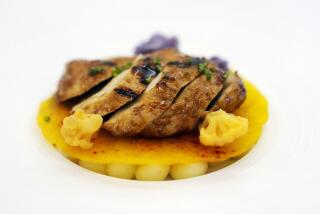Fungus Food Poses Meaty Dilemma
WASHINGTON — A fake meat that is made from fungus, but looks and tastes like chicken, has arrived in U.S. supermarkets. In Europe, the meat substitute rivals soyburgers and similar products in popularity.
Known as mycoprotein, it is marketed under the trade name Quorn (pronounced kworn) and made into a variety of products, including chicken-like nuggets, lasagna and fettuccine Alfredo--even an alternative to ground beef, called “grounds.”
“It’s wonderful as far as consumers are concerned,” said Leslie Bonci, a nutrition specialist who first tried mycoprotein in a London restaurant. “It’s a lot of protein for a minimal amount of calories and three to four grams of fiber.”
Scientists found the fungus growing on farms west of London in the 1960s and discovered that its long strands could be made into a product that mimicked the fibrous tissue of meat.
The fungus is now grown through fermentation, mixed with egg and flavorings and fashioned into imitation chicken or beef.
The product was developed by a subsidiary of the Anglo-Swedish pharmaceutical giant AstraZeneca and introduced in Britain in 1985. It is now eaten in one in 20 British households, the company says, and is sold in six other European countries. It arrived in U.S. stores in January after getting approval from the Food and Drug Administration.
“I think it’s got a lot of potential. We just have to make sure fungus is not going to appear on the label anywhere,” said Bonci, director of sports nutrition at the University of Pittsburgh Medical Center.
It doesn’t.
Labels on Quorn products say that mycoprotein “comes from a small, unassuming member of the mushroom family, which we ferment like yogurt.”
That sounds much more appealing than calling it a fungus--mycoprotein means fungal protein--but it also is not accurate, critics say.
“It has as much to do with mushrooms as you and I have to do with salamanders,” said Michael Jacobson, executive director of the advocacy group Center for Science in the Public Interest. “We all know what a mushroom looks like. This ain’t it.”
His group has complained to the FDA about the label, and says the agency should not have approved mycoprotein without requiring more review of its potential to cause allergic reactions, because it has not been consumed in this country before.
A panel of U.S. scientists that reviewed the product at the manufacturer’s expense decided there was little chance that people would be allergic to Quorn and that the product had many nutritional benefits. Their report, published last year in the journal Food Technology, was submitted to the government.
“I think it’s going to lend itself to a lot of different things, particularly for people who want to limit their intake of meat protein,” said Sanford Miller, a former FDA food safety chief who headed the panel.
A serving of Quorn nuggets has 180 calories, eight grams of fat (about six less than chicken nuggets), three grams of fiber and no cholesterol. A 10.6-ounce box of the product sells for $3.69 in Washington-area stores.
Quorn’s maker had $150 million sales in Europe last year and is projecting 20% growth this year with the U.S. introduction. It’s sold in about 200 U.S. natural-foods stores and supermarkets.
Two-thirds of all new food products fail within two years, but this one may be different, said John Lord, a professor of food marketing at St. Joseph’s University. “It sounds like it’s a really good opportunity for people who want to eat healthy but still have some sort of sensory satisfaction.”
More to Read
Eat your way across L.A.
Get our weekly Tasting Notes newsletter for reviews, news and more.
You may occasionally receive promotional content from the Los Angeles Times.








